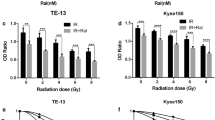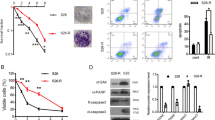Abstract
The purpose of this study was to evaluate the radiation-enhancing effect of sodium glycididazole, and the corresponding mechanisms of action on laryngeal cancer cells. Two laryngeal cancer cell lines (Hep-2 and UT-SCC-19A) were irradiated with X-rays in the presence or absence of sodium glycididazole. Cell survival, DNA damage and repair, cell apoptosis, cell cycle distribution, expression of proteins related to cell cycle checkpoint, and apoptosis were measured. Significantly increased DNA damages, decreased cells in the G1 phase, arrested cells at G2/M phase, decreased DNA repair protein XRCC1 foci formation, and enhanced cell apoptosis were observed in laryngeal cell lines treated by sodium glycididazole combined with irradiation compared with the irradiation alone. The combined treatment downregulated the protein expressions of ataxia–telangiectasia mutated (ATM), p-ATM, CHK2, and P53 but upregulated the protein expressions of MDM2 and Cdk2. This study indicates that sodium glycididazole enhances the radiosensitivity of laryngeal cancer cells through downregulation of ATM signaling pathway in vitro and in vivo.






Similar content being viewed by others
References
Lefebvre JL. Laryngeal preservation in head and neck cancer: multidisciplinary approach. Lancet Oncol. 2006;7(9):747–55.
Forastiere AA, Zhang Q, Weber RS, Maor MH, Goepfert H, Pajak TF, et al. Long-term results of RTOG 91–11: a comparison of three nonsurgical treatment strategies to preserve the larynx in patients with locally advanced larynx cancer. J Clin Oncol. 2013;31(7):845–52.
Machtay M, Moughan J, Trotti A, Garden AS, Weber RS, Cooper JS, et al. Factors associated with severe late toxicity after concurrent chemoradiation for locally advanced head and neck cancer: an RTOG analysis. J Clin Oncol. 2008;26(21):3582–9.
Overgaard J. Hypoxic radiosensitization: adored and ignored. J Clin Oncol. 2007;25(26):4066–74.
Ke Q, Wu J, Ming B, Zhu S, Yu M, Wang Y, et al. Identification of the PAG1 gene as a novel target of inherent radioresistance in human laryngealcarcinoma cells. Cancer Biother Radiopharm. 2012;27(10):678–84.
Rastogi RP, Richa, Kumar A, Tyagi MB, Sinha RP. Molecular mechanisms of ultraviolet radiation-induced DNA damage and repair. J Nucleic Acids. 2010;2010:592980.
Schaue D, McBride WH. Counteracting tumor radioresistance by targeting DNA repair. Mol Cancer Ther. 2005;4(10):1548–50.
Sarkaria JN, Busby EC, Tibbetts RS, Roos P, Taya Y, Karnitz LM, et al. Inhibition of ATM and ATR kinase activities by the radiosensitizing agent, caffeine. Cancer Res. 1999;59(17):4375–82.
Golding SE, Rosenberg E, Khalil A, McEwen A, Holmes M, Neill S, et al. Double strand break repair by homologous recombination is regulated by cell cycle-independent signaling via ATM in human glioma cells. J Biol Chem. 2004;279(15):15402–10.
Lavin MF. ATM activation and DNA damage response. Cell Cycle. 2007;6(8):931–42.
Burma S, Chen BP, Murphy M, Kurimasa A. ATM phosphorylates histone H2AX in response to DNA double-strand breaks. J Biol Chem. 2001;276(45):42462–7.
Podhorecka M, Skladanowski A, Bozko P. H2AX Phosphorylation: Its Role in DNA Damage Response and Cancer Therapy. J Nucleic Acids 2010 2010.
Dasika GK, Lin SC, Zhao S, Sung P, Tomkinson A, Lee EY. DNA damage-induced cell cycle checkpoints and DNA strand break repair in development andtumorigenesis. Oncogene. 1999;18(55):7883–99.
Toulany M, Mihatsch J, Holler M, Chaachouay H, Rodemann HP. Cisplatin-mediated radiosensitization of non-small cell lung cancer cells is stimulated by ATM inhibition. Radiother Oncol. 2014;111(2):228–36.
Guo X, Yang C, Qian X, Lei T, Li Y, Shen H, et al. Estrogen receptor α regulates ATM Expression through miRNAs in breast cancer. Clin Cancer Res. 2013;19(18):4994–5002.
Hennig J, McShane MP, Cordes N, Eke I. APPL proteins modulate DNA repair and radiation survival of pancreatic carcinoma cells by regulating ATM. Cell Death Dis. 2014;5:e1199.
Ma CQ, Yang Y, Wang JM, Du GS, Shen Q, Liu Y, et al. The aPKCι blocking agent ATM negatively regulates EMT and invasion of hepatocellular carcinoma. Cell Death Dis. 2014;5:e1129.
Zeng YC, Wu R, Xu ZG, Zhang XY, Fan GL, Wu LN, et al. Safety and radiation-enhancing effect of sodium glycididazole in locoregionally advanced laryngeal cancers previously treated with platinum-containing chemotherapy regimens: a preliminary report. Cancer Radiother. 2010;14(1):59–64.
Fu LQ, Huang F, Guo JH, Gao HZ, Liang YQ, Li J, et al. Phase I clinical pharmacokinetics of glycididazolum natrium. Chin J Pharmacol Toxicol. 2004;18:87–92.
Cai L, Liu MZ, Gu MF, Liu H, Chen EC, Hu YH, et al. Phase I study of CM-Na combined with concurrent radiochemotherapy for advanced esophageal carcinoma. Ai Zheng. 2005;24(5):582–6.
Yang J, Liu MZ, Cai L, Hu YH, Liu H, Li QQ, et al. Phase II clinical trial of sodium glyci-didazole (CM-Na) combined with concurrent radiochemotherapy for advanced esophageal carcinoma. Ai Zheng. 2008;27(6):622–6.
Sugie C, Shibamoto Y, Ito M, Ogino H, Suzuki H, Uto Y, et al. Reevaluation of the radiosensitizing effects of sanazole and nimorazole in vitro and in vivo. J Radiat Res. 2005;46(4):453–9.
Tichý A, Vávrová J, Pejchal J, Rezácová M. Ataxia-telangiectasia mutated kinase (ATM) as a central regulator of radiation-induced DNA damage response. Acta Med (Hradec Kralove). 2010;53(1):13–7.
Zheng X, Gao J, Zhang H, Zhang H, Zhu Q, Meng X, et al. Radiosensitizing efficiency of sodium glycididazole on v(79) cells in vitro. J Radiat Res Radiat Proc. 1995;3:213–8.
Zhang Q, Zhang C, He J, Guo Q, Hu D, Yang X, et al. STAT3 inhibitor stattic enhances radiosensitivity in esophageal squamous cell carcinoma. Tumour Biol. 2015;36(3):2135–42.
Kuribayashi K, El-Deiry WS. Regulation of programmed cell death by the p53 pathway. Adv Exp Med Biol. 2008;615:201–21.
Kim WJ, Vo QN, Shrivastav M, Lataxes TA, Brown KD. Aberrant methylation of the ATM promoter correlates with increased radiosensitivity in a human colorectal tumor cell line. Oncogene. 2002;21(24):3864–71.
Smith J, Tho LM, Xu N, Gillespie DA. The ATM-Chk2 and ATR-Chk1 pathways in DNA damage signaling and cancer. Adv Cancer Res. 2010;108:73–112.
Ferguson DO, Sekiguchi JM, Frank KM, Gao Y, Sharpless NE, Gu Y, et al. The interplay between nonhomologous end-joining and cell cycle checkpoint factors indevelopment, genomic stability, and tumorigenesis. Cold Spring Harb Symp Quant Biol. 2000;65:395–403.
Stucki M, Stagljar I, Jónsson ZO, Hübscher U. A coordinated interplay: proteins with multiple functions in DNA replication, DNA repair, cell cycle/checkpoint control, and transcription. Prog Nucleic Acid Res Mol Biol. 2001;65:261–98.
Acknowledgments
This work was supported by the National Natural Science Foundation of China (No. 81201803) and by a grant from Luye Pharma Group Ltd. (Shanghai, China).
Author information
Authors and Affiliations
Corresponding author
Ethics declarations
Conflicts of interest
None
Rights and permissions
About this article
Cite this article
Zeng, YC., Xing, R., Zeng, J. et al. Sodium glycididazole enhances the radiosensitivity of laryngeal cancer cells through downregulation of ATM signaling pathway. Tumor Biol. 37, 5869–5878 (2016). https://doi.org/10.1007/s13277-015-4278-1
Received:
Accepted:
Published:
Issue Date:
DOI: https://doi.org/10.1007/s13277-015-4278-1




